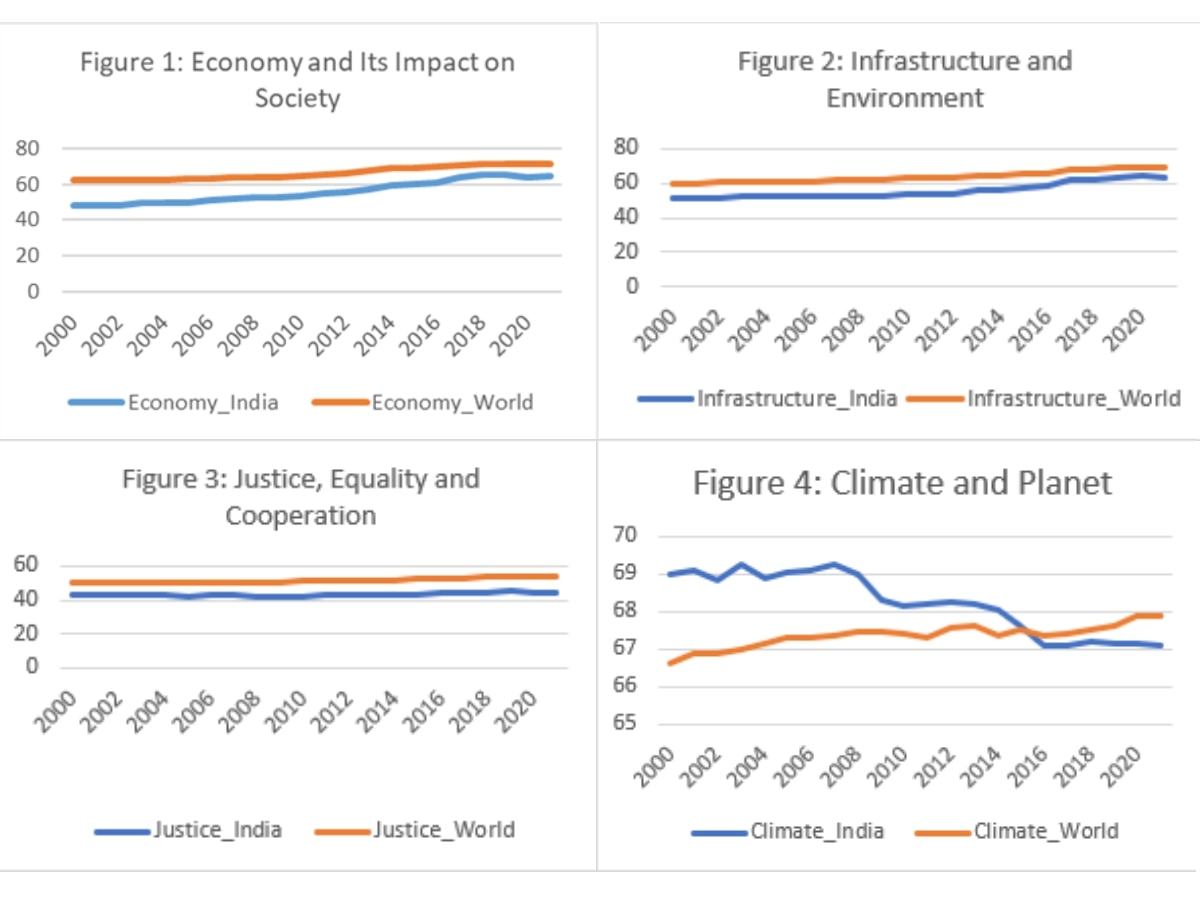How India Fares On Sustainable Development Goals — 4 Graphs Offer An Insight
The road ahead is an opportunity for India, which can play a leadership role. To get there, it is important that India starts evaluating policies with a strong focus on its possible impact on SDGs.

With India assuming the presidency for G20, it is important that we analyse the journey so far for the country as one of the key players in attaining the Sustainable Development Goals (SDGs). In September 2015, as many as 193 countries came together at the United Nations to adopt and commit to 17 SDGs with 169 sub-goals. India, a signatory to the 2030 Agenda for Sustainable Development, has launched several developmental programmes aimed at meeting all 17 SDGs in a time-bound manner. As the most populous nation in the world, and the world’s fifth largest economy, India’s success in achieving the SDGs will largely determine global outcomes. In this backdrop, and with the halfway mark to 2030 already reached, it would be critical to assess where India stands and also chalk out the roadmap ahead.
India’s progress can be analysed using four graphs (1-4). While the 17 SDGs are all-encompassing and perhaps even overlapping, one can group them into four broad categories: Economic Prosperity and its impact on the Society (SDGs 1,2,3,4 and 8), Infrastructure and Environment (SDGs 6,7,9,11 and 12), Justice, Equality and Cooperation (SDGs 5,10,16 and 17) and Climate Change and its impact on the Planet (SDGs 13,14 and 15). The classification is based on the interconnectedness of the first two groups and independence of the groups 3 and 4.
The Sustainable Development Report (2022) by Sachs, Lafortune, Kroll, Fuller and Woelm is a good starting point. The data provides SDG Index scores of 163 countries (of the 193 signatories) in terms of their progress against each of the 17 SDGs, qualifying the progress in terms of “On track or maintaining achievement”, “Moderately increasing”, and “Stagnating” and “Decreasing”. The index is constructed by giving equal weightages to SDG components and sub components. The background data is mostly based on World Development Indicators by the World Bank.

The four diagrams present a few clear trends. Firstly, while for the world as well as for India, the improvements are marginal when it comes to goals that try to promote economic growth, infrastructure and environment, and it has hardly improved when it comes to ensuring justice, equality and cooperation among all. Worryingly for India, we have consistently underperformed compared to the rest of the world with the gap getting bridged at a painstakingly slow rate. However, a critical pattern emerges when it concerns climate action and its impact on other life forms. This was one area where India was performing better than the rest, but over the last two decades we have been scoring less, so much so that we now score below the global standard. Thus, a brief snapshot of India’s SDG journey between 2000-2020 presents more than a mixed picture. There appears to be a pattern — India has focused far more on economic prosperity than other objectives.
Hits And Misses, And The Opportunity Ahead
Analysing the data in detail suggests that the specific parameters where India has improved are directly related to economic policies that promote GDP growth and its effect on improved infrastructure-both physical as well as human capital. It is heartening to see that many of the intended positive spillovers of high GDP growth are being observed. India has definitely improved substantially regarding health and education outcomes, water and sanitation, access to electricity as well as connectivity. This is a story of being future ready. The journey has been impressive too as India scores above the rest when it comes to responsible consumption and production. India has done better than the world in terms of fossil fuel subsidies (consumption and production) as a proportion of total GDP (%), lower household food waste per capita, and lower per capita hazardous waste.
However, there are areas where higher GDP growth should also have seen positive spillovers but it has not. For one, it is not creating enough opportunities for the youth. The proportion of youth in the age group 15-24 who are not in education, employment or training has remained between 28%-30% as compared to a global average of 23% during this period. Even more worryingly, high growth has not translated to substantial reduction in either poverty, hunger or inequality.
There are areas where India is lagging behind, which may not automatically get addressed with high economic achievements. Both India and the world appear to have failed to deliver in its promises to ensure justice and equality. Specifically on the aspect of gender equality, the gap between the world and India is significant and has remained almost unbridged. The Indian story is under the scanner when one considers Climate Change and its impact on the Planet. While India was performing significantly better than the world at the beginning of the century, this pattern has reversed in the last few years with a widening gap. The last point is particularly worrying as many economic decisions are coming at the cost of destroying and displacing natural habitats.
The road ahead is an opportunity for India. With some impressive achievements and significant presence, India can guide the rest of the world by taking a leadership role in promoting justice and equality by being at the hub of inter-country cooperation. We can particularly do that with respect to strong protection of the environment to mitigate climate-related disasters. Given that India has demonstrated impressive economic growth rate along with very modest negative environmental footprints, it is in a natural leadership position to drive cooperative agendas, a role it must strongly advocate. To get there, it is important that India starts evaluating its policies with a strong focus on its possible impact on SDGs.
The authors are faculty at Great Lakes Institute of Management, Gurgaon.
[Disclaimer: The opinions, beliefs, and views expressed by the various authors and forum participants on this website are personal.]
Related Video
India@2047 Summit: Modi Calls for Innovation, Reforms, and National Resolve





































